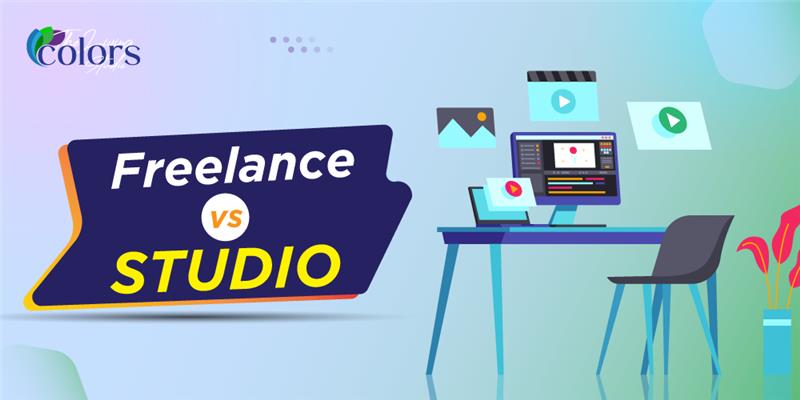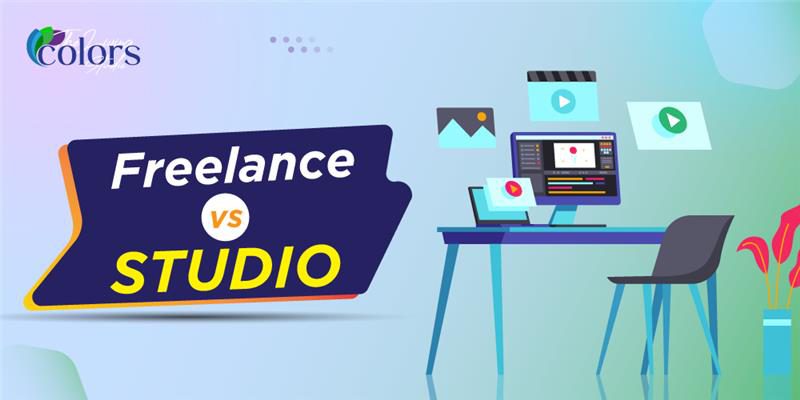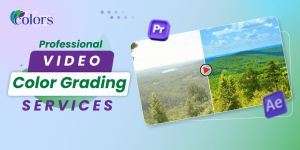Color can make or break your video. Whether it’s a commercial, film, or product video, professional color grading sets the mood, refines the tone, and ensures your visuals tell a consistent story. But when it comes time to hire someone for the job, most people get stuck on one key question: Should you work with a freelance video colorist or a professional color grading studio?
Both options have their advantages and potential drawbacks. Choosing the right one depends on your project’s scale, budget, timeline, and creative expectations. In this article, we’ll take a closer look at the differences between freelance and studio colorists, what each brings to the table, and how to decide which option fits your needs best.
Suppose you’re searching for expert color grading support. In that case, you can also check out our Video Color Grading Services at The Living Colors Studio, where our experienced team brings visuals to life with cinematic precision and emotion-driven color science.
Table Contents
- 1 Understanding the Role of a Video Colorist
- 2 Who Is a Freelance Video Colorist?
- 3 What Is a Video Color Grading Studio?
- 4 Freelance vs. Studio: A Detailed Comparison
- 4.1 When to Choose a Freelance Colorist
- 4.2 When to Choose a Studio Colorist
- 4.3 Which Option Is Right for You?
- 4.4 Why Many Businesses Prefer Studios Like The Living Colors Studio
- 4.5 1. What does a video colorist do?
- 4.6 2. Is hiring a freelance colorist cheaper than a studio?
- 4.7 3. What software do professional colorists use?
- 4.8 4. Can studios handle large-scale or commercial projects better?
- 4.9 5. How do I choose between a freelance and studio colorist?
- 5 Final Thoughts
Understanding the Role of a Video Colorist
Before comparing freelancers and studios, it’s essential to understand what a video colorist actually does.
A video colorist enhances the visual tone and feel of a video through color correction and color grading. This process ensures that every shot matches in brightness, contrast, and color temperature, while also helping the footage convey a specific mood, whether it’s a warm romantic scene or a fabulous, futuristic product showcase.
Color Correction vs. Color Grading
- Color correction addresses inconsistencies and technical issues in your footage, such as mismatched shots, lighting differences, or camera exposure errors.
- Color grading adds the creative look and the cinematic tone that give your video its emotional and visual depth.
This means your choice of colorist affects not only the technical accuracy of your video but also its creative impact.
Who Is a Freelance Video Colorist?
A freelance video colorist is an independent professional who offers color correction and grading services on a per-project basis. Freelancers often work remotely, using their own equipment and software, such as DaVinci Resolve, Adobe Premiere Pro, or Final Cut Pro.
Pros of Hiring a Freelance Colorist
Hiring a freelance video colorist can be a cost-effective option for many creators and businesses. Since freelancers work independently and don’t carry the overhead costs that studios do, their rates are often more affordable while still offering professional-quality results.
They’re also known for their flexibility, often adapting to changing project timelines or last-minute adjustments with ease. Another significant advantage is direct communication, as you work one-on-one with the person handling your project, which makes feedback faster and collaboration smoother.
Many freelancers also take a personalized approach, tailoring their color grading style to fit your creative vision and ensuring that your final video reflects your unique aesthetic.
Cons of Hiring a Freelance Colorist
While freelancers can be an excellent choice for smaller projects, they do come with certain limitations. One of the main challenges is limited resources — freelancers often lack access to the same high-end studio equipment, advanced color monitors, or specialized plugins that professional studios utilize.
They also face capacity constraints, as a single person can only handle a certain amount of work at once, which can affect the turnaround time for larger or more complex projects. Reliability can be another concern, as their availability and consistency may vary depending on other ongoing commitments.
Lastly, scalability becomes an issue when managing multiple videos or large campaigns, as a solo freelancer may struggle to handle the full scope efficiently.
What Is a Video Color Grading Studio?
A color grading studio is a professional facility with a team of colorists, editors, and post-production specialists. Studios like The Living Colors Studio offer comprehensive post-production support, from basic color correction to complete cinematic grading, for commercial, fashion, and product videos.
Pros of Working with a Studio
Working with a professional color grading studio offers several clear advantages. Studios have access to top-tier hardware, calibrated reference monitors, and professional-grade software, ensuring every project meets broadcast-level color accuracy.
Their team-based setup brings together multiple specialists, which enhances consistency, efficiency, and overall quality control throughout the grading process. With numerous professionals working simultaneously, studios can handle larger workloads and deliver projects more efficiently without compromising quality.
Beyond technical capabilities, established studios bring years of creative expertise and a refined understanding of color aesthetics that align perfectly with brand storytelling. They also offer greater reliability and support through project managers, structured workflows, and clear revision policies, making the entire process smoother and more professional.
Cons of Working with a Studio
Working with a studio can be more expensive, as their services often include advanced tools and a whole team of professionals. Studios also tend to follow structured processes, which can feel less flexible or personal than working directly with a freelancer. Additionally, communication often goes through a project manager rather than directly with the colorist, which can add an extra layer to the feedback process.
Freelance vs. Studio: A Detailed Comparison

| Criteria | Freelance Colorist | Studio Colorist |
| Cost | Lower (ideal for smaller projects) | Higher, but includes full service and equipment |
| Turnaround Time | Slower for large projects | Faster due to team capacity |
| Quality Control | Depends on individual skill | Ensured by studio standards |
| Communication | Direct, personal | Structured, through the team/project manager |
| Equipment & Software | Depends on the freelancer’s setup | Professional-grade systems and monitors |
| Scalability | Limited | High, multiple projects handled simultaneously |
| Reliability | Varies by person | Consistent and contract-based |
| Creative Collaboration | Personalized | Strategic and team-driven |
When to Choose a Freelance Colorist
Freelancers are ideal for projects that require a personal touch, have smaller budgets, or flexible timelines. Here are a few ideal scenarios:
- Working on a short film, social media video, or music video.
- Already have a clear vision and need someone to bring it to life.
- Prefer direct communication and want more creative control.
- The project doesn’t require studio-level color precision or multiple format outputs.
If you find a freelance colorist whose style aligns with your creative direction and whose portfolio resonates with your vision, it can be a rewarding collaboration.
When to Choose a Studio Colorist
A color grading studio is ideal for commercial, corporate, or high-production-value projects. Choose a studio when:
- You need consistent results across multiple videos or campaigns.
- The project involves brand storytelling, advertising, or product marketing.
- You want your visuals to meet professional or broadcast standards.
- You prefer structured workflows, fast delivery, and post-project support.
Which Option Is Right for You?
The answer depends on your goals, budget, and expectations.
- If your focus is on affordability and creative intimacy, a freelance colorist might be your best fit.
- If you prioritize quality, reliability, and scalability, partnering with a studio colorist is the more intelligent choice.
Think of it this way:
- A freelancer is like hiring an artist: flexible, creative, and personalized.
- A studio is like hiring a production team – structured, precise, and built for excellence.
Why Many Businesses Prefer Studios Like The Living Colors Studio
Professional studios go beyond grading; they elevate your brand’s visual storytelling. At The Living Colors Studio, every project undergoes detailed analysis, from color palette selection to tone consistency. Our experienced colorists use advanced tools and cinematic techniques to enhance mood, emotion, and realism.
Whether it’s commercial color grading, product video enhancement, or creative film grading, we provide results that reflect your brand identity and resonate with your audience.
You can explore our Video Color Grading Services to see how our studio helps businesses and creators achieve a professional, polished finish that stands out on every platform.
1. What does a video colorist do?
A video colorist adjusts the color, tone, and mood of your footage to create visual consistency and emotional depth across scenes.
2. Is hiring a freelance colorist cheaper than a studio?
Yes, freelancers generally cost less. However, studios offer additional value through advanced equipment, multiple experts, and guaranteed quality.
3. What software do professional colorists use?
Most professionals use DaVinci Resolve, Adobe Premiere Pro, or Final Cut Pro for color correction and color grading.
4. Can studios handle large-scale or commercial projects better?
Yes. Studios have dedicated teams, making them ideal for efficiently handling commercial, branded, or large-scale video projects.
5. How do I choose between a freelance and studio colorist?
Assess your budget, timeline, and creative goals. If you want high-end, consistent, and professional results, a studio is the right choice.
Final Thoughts
When deciding between a freelance video colorist and a studio, the key is understanding your priorities. If you’re working on a personal or passion project, a freelancer can be an excellent creative partner. However, if you require dependable delivery, advanced tools, and professional-grade visuals, a studio like The Living Colors Studio is your best bet.
At the end of the day, color isn’t just about aesthetics. It’s about storytelling. Choosing the right colorist means selecting how your audience will perceive your story.
If you’re ready to take your video visuals to the next level, get in touch with The Living Colors Studio, where color meets creativity, and your vision becomes cinematic reality.








